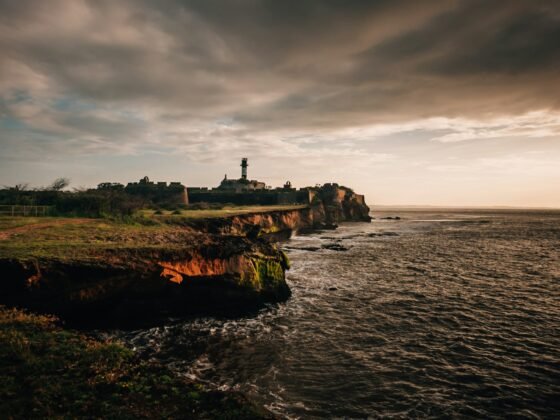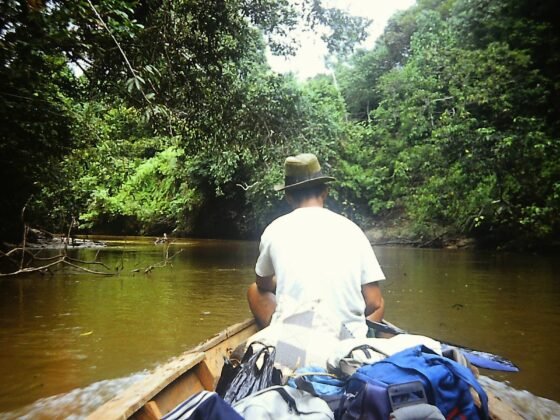by Penelope Drastik
Shortlisted in the PureTravel Writing Competition 2023
The basalt columns towered above us, framing the entrance to the cave like an archway in a grand cathedral. The sunless sea swept inside. The tumult of the waves was matched only by the frenzied energy aboard our boat, as everyone jostled for position, standing on seats or tables to catch their first glimpse of it. All thirty people took photos, leaning as far as they dared over the side of the boat for a better view. When the boat turned around, all thirty people rushed to the other side to take photos again. We were on our way across the Inner Hebrides, to the magical Fingal’s Cave.
“I didn’t know it was a real place!” my father had said, when I told him about my summer holiday plans. I hadn’t either. We both knew Mendelssohn’s famous ‘Fingal’s Cave Overture’ – then one day, I was idly flicking through a list of day trips in Scotland…
A few months later, I leaped off the boat onto a pier dwarfed by the huge columns of volcanic rock surrounding the island of Staffa. The waves were grey, the clouds were grey, the cliffs were grey. Tufts of grass peeked over the edge of the cliffs, the only splash of colour on the landscape, inviting us to climb up the creaky metal staircase from the sea to the sky.
In turn, we squelched across the island’s welcome mat – a hospital-green disinfectant pad intended to remove anything dangerous from our shoes before we reached the puffin colony nesting on the rocks. On the boat trip we had already seen sunbathing seals and diving dolphins, and Staffa, though uninhabited by humans, was home to many seabirds during the summer months. Our first view of the puffins was a cloud of tiny black dots against the side of the cliff, but as we got closer and settled ourselves on the ground the puffins came to land on the grass, waddling over and looking at us just as curiously as we looked at them. In contrast to the frantic scramble on the boat, the whole group sat still as the puffins hopped ever closer. I could barely hear the faint sound of the sea, so far below the cliff tops. The lifeless ocean faded into the background as more and more puffins pranced around us, flying away, flying back, darting through the tall grass and flapping madly. The puffins love receiving visitors – when people are around they feel safe from the seagulls, and will rush from their cliff-side homes to welcome the tourists.
“Fingal’s Cave – over there. Ten minute walk.” the captain had explained as we got off the boat. I naively thought this would be something like a footpath across the island, perhaps leading to another entrance of the cave away from the savage sea. Alas! The only way to reach Fingal’s Cave is to climb around the side of the island, over columns of rock between the cliffs and the waves, each a different height but all of them nearly perfect hexagon shapes. The patchwork of pillars was formed by a lava flow millions of years ago. I looked ahead from the starting point of the route, my eyes following a single rope-like handrail marking out the best path to take. The columns on this path were fairly flat but to my left there were towering curved pillars, remembering their past life as a burst of lava while today they sat stuck in position as a rocky wave about to break. The dancing rocks were battered by the sea while I was suddenly battered by rain. The already-treacherous path to the cave was quickly becoming slippery, as was the handrail, which was made of a smooth plastic that I could now hardly grip.
I slowly stepped from stone to stone, wondering if any previous visitors had lost their footing and disappeared into the swirling sea. I thought about my parents, who often worried over my solo travels, warning me against all sorts of dangers: budget airlines, cobblestone streets (“your shoes aren’t good enough!”), street food, walking tours (“what if you can’t keep up with them?”), any staircases that might be too steep or too small or too high, and so on and so on. They would certainly be horrified if they could see me dragging myself across the rocky outskirts of a tiny island far away from any hospitals or indeed any sort of civilisation.
As I slid further along the bizarre hexagonal hopscotch of a path to the cave, I encountered a new problem – other people. Our group had split into two upon reaching the island, with half of us heading to the puffins, and the others heading straight to the cave. But now, my trek to the cave was interrupted every so often by people making the return journey. Unlike the road, where right of way is carefully codified in the law, the question of who was entitled to the single slippery handrail on the Staffa cliffs was much more nuanced. Very occasionally, there would be a plateau of larger rocks where it was possible to clamber past each other safely. The rest of the time, whichever person looked more stable on their feet would find a rock to balance on until the other party had made it through. As I perched like an overgrown puffin on the steep basalt pillars, I watched an elderly couple scramble past, and felt a little more confident that my 20-something self could last the day without falling to a gruesome death or being swept away by the sea.
Soon, I was approaching the final obstacle – a broken section of railing on the rough ridges leading to the cave entrance. I had chosen the perfect moment to visit the cave, as the previous group had started on their way back, leaving a space of about ten minutes where the cave was mine alone. The experience was guaranteed to be breathtaking – literally, I thought, as I puffed and panted my way up each step. Three more hexagons. Two more hexagons. I reached the final stair, ready to begin the overture…
I stood in a measureless cavern, the sea seething ceaselessly at the cave entrance before becoming shadowy waves that broke into blackness. Colours blossomed in the cave, defying the grey Scottish summer outside – red rocks, orange rocks, yellow rocks – colour stained the rocky walls like musical notes scattered across a page, and as waves rushed in the music echoed and swelled and echoed and quelled – and at once was silent. The still sea sparkled in the sunlight. I sat atop a jagged pillar of rock that felt icy even through my thick layers of clothes. To my left, through a distant mist, lay the island of Iona with its white sand beaches and gentle, warm waters. To my right, barely visible in the dark, lay further mysteries of the cave, which could not be reached on foot. Crash! The music began again, as a fresh set of waves rushed over the rocks in a crescendo, singing the same song they had sung to Mendelssohn many years ago, singing of journeys, singing of solitude, singing endlessly into the deep chasm – and again there was silence. Fingal’s Cave was chaotic and peaceful, roaring and whispering, a vision in a dream yet so real and solid around me.
Photo by Desiré Kranenburg on Unsplash












